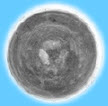Clemson University
Community for the latest research in new membrane materials.

Regenerable Coatings of Nanoparticles on Reverse Osmosis Membranes to Facilitate Foulant Removal
Regenerable Coatings of Functionalized Titanium Dioxide and Silver Nanoparticles on Reverse Osmosis Membranes to Facilitate Foulant Removal
Introduction
Seawater desalination is an increasingly important alternative for producing fresh water.
Zeta Potential (mV)
50 40 30 20 10 0 -10 -20 -30 -40
Carly A. Barnard Megan A. Smith, David A. Ladner
Environmental Engineering and Earth Sciences CLEMSON UNIVERSITY
Results
SWC4 PolyDADMAC Coating Characterization
Discussion
Nanoparticle Deposition on Membrane Surface: Self-adsorption enabled pD to adhere to the surface of SW30HR membranes, as demonstrated by the increase in zeta potential in Figure 3. Self-adsorption of the TiO2-PA(-) and Ag-PA(-) NPs to the pD coated SW30HR membrane decreased the zeta potential from that of the pD coated membrane (Figure 3). Comparison of Images (a) and (b) in Figure 5 illustrates deposition of Ag-PA(-) NPs through the appearance of white areas in Image (b). Coating Removal: pH 1 soak restored the zeta potential near that of the virgin membrane (Figure 3) for both NP coated membranes, demonstrating some removal of the pD and NP coatings.
Virgin Coated pH 1 pH 13
Seawater desalination processes are plagued by foulants, decreasing the water flux, impeding process efficiency, and shortening membrane life.
SWC4 w/2% pD HCl SWC4 w/2% pD NaOH Uncoated SWC4 HCl Uncoated SWC4 NaOH
Objectives
Explore the use of negatively charged nanoparticle (NP) coatings composed of titanium dioxide (TiO2-PA(-)) and silver (Ag-PA(-)) on reverse osmosis (RO) membranes to facilitate the removal of foulants and to regenerate the membranes. Effectively deposit NPs on the membrane. Utilize a pH soak to remove the NP coatings.
-50 2 3 4 5 6 7 8 9 10
pH Figure 2: SurPASS titration curves for virgin and 2% pD coated SWC4 membranes (Hydranautics). The pD coating increased the zeta potential compared to the virgin membrane.
TiO2-PA(-) and Ag-PA(-) Deposition and Removal
20 15 10 5 0 -5 -10 -15 -20
Zeta Potential (mV)
Incomplete removal of Ag-PA(-) NPs after pH 1 soak is evident in Image (c) of Figure 5 through the appearance of small white areas. pH 13 soak increased the zeta potential compared to the NP coated membranes (Figure 3), showing NP removal and small degrees of pD removal. Effective Ag-PA(-) NP removal is evident in Image (d) of Figure 5 through no appearance of white areas.
Experimental Methods
PolyDADMAC (pD), a positively charged polymer, was used as a bridge between the RO membrane (Filmtec SW30HR) and the negative nanoparticles, which are incorporated with polyacrylate polymers, to enable effective deposition on the membrane surface. Ten percent TiO2-PA(-) and 10% Ag-PA(-) solutions, along with 0.2% pD solution, were used to coat the membranes through a selfadsorption method. The membranes were run through an electrokinetic analyzer (SurPASS, Anton-Paar, Austria) after deposition and removal processes to determine their surface charge, or zeta potential. Single measurements were taken at a pH between 5.50 and 5.80.
Streaming Liquid
SW30HR
SW30HR and pD SW30HR/pD and SW30HR/pD and Ag-PA(-) TiO2-PA(-)
Membrane and Coating
Figure 3: Zeta potential measurements for deposition and removal procedures.
Contact Angle Coating Characterization
SW30HR/pD and Ag-PA(-) SW30HR/pD and TiO2-PA(-) SW30HR and pD
(a)
Conclusions
TiO2-PA(-) and Ag-PA(-) NP coatings on SW30HR membranes can effectively be deposited through selfadsorption with a pD bridge layer.
SW30HR
0 20 40 60 80 100 120
pH 1 and pH 13 soaks remove the NP coatings.
V
Sample Cell
Electrodes
Figure 1: SurPASS streaming current measurement cell. The SurPASS calculates the zeta potential of the membrane surface by measuring the streaming current with the electrodes on both ends of the sample cell.
(b)
Contact Angle (Degrees)
Figure 4: Contact angle measurements using sessile drop method. pD increases the membrane’s hydrophobicity, while TiO2-PA(-) and Ag-PA(-) coatings are similar in hydrophilicity to the virgin membrane.
Future Work
• Examine the use of ionic-strength techniques to remove coatings. • Consider the effects of each coating on water flux. • Investigate the effectiveness of foulant removal via nanoparticle coating removal. • Apply coating removal to the desalination process.
Nanoparticle coating removal experiments were performed by soaking the coated membranes in solutions of pHs 1 and 13 for 6 hours. Contact angle measurements confirmed deposition. Scanning electron microscopy (SEM) confirmed coating deposition and removal.
(c) (d)
Figure 5: SEM images with magnification x10000. (a) polyDADMAC coating. (b) AgPA(-) coating. (c) Ag-PA(-) coating after pH 1 soak. (d) Ag-PA(-) coating after pH 13 soak.
Acknowledgements: This work was part of the Advanced Functional Membranes Research Experiences for Undergraduates program at Clemson University. Support for this REU program was provided by the National Science Foundation under award EEC 1061524. Visit our website at www.clemson.edu/ces/chbe/reu/index.html
